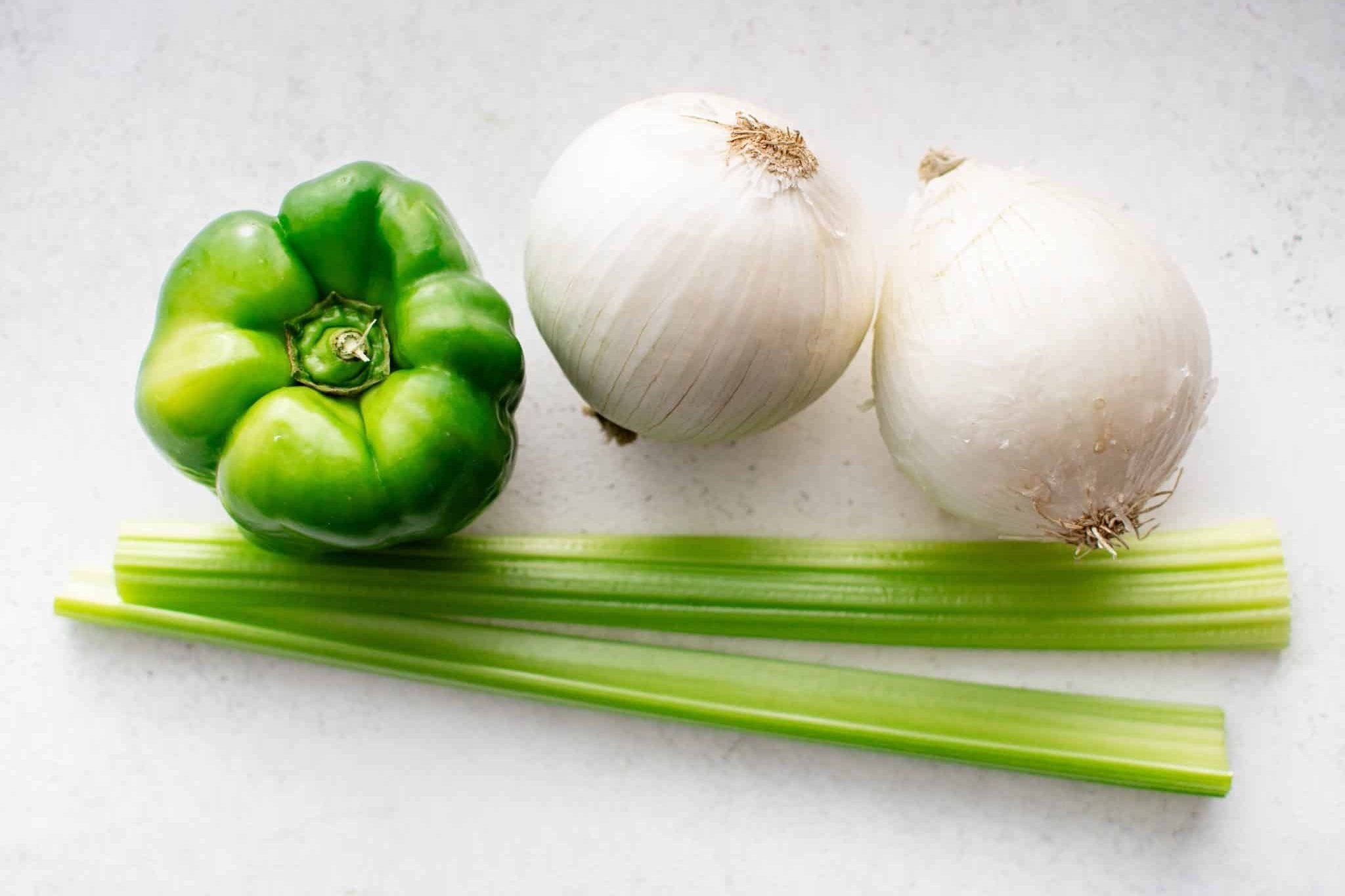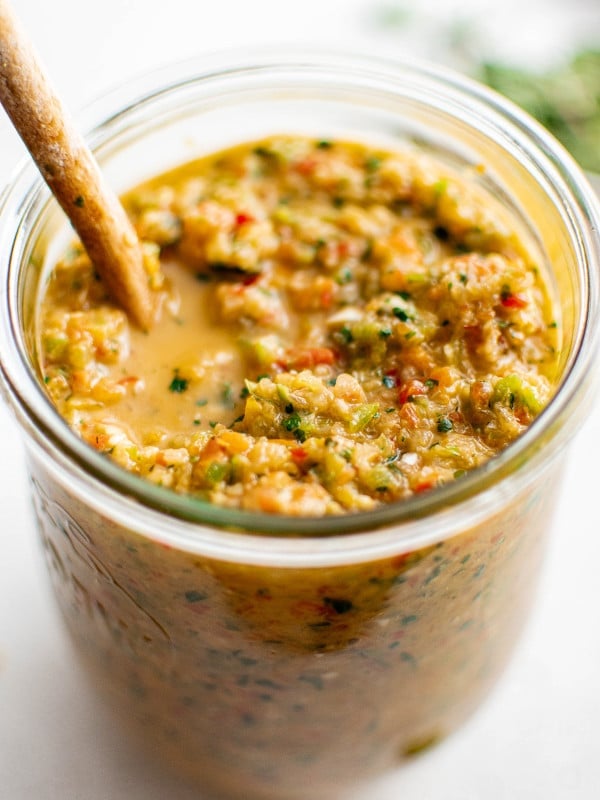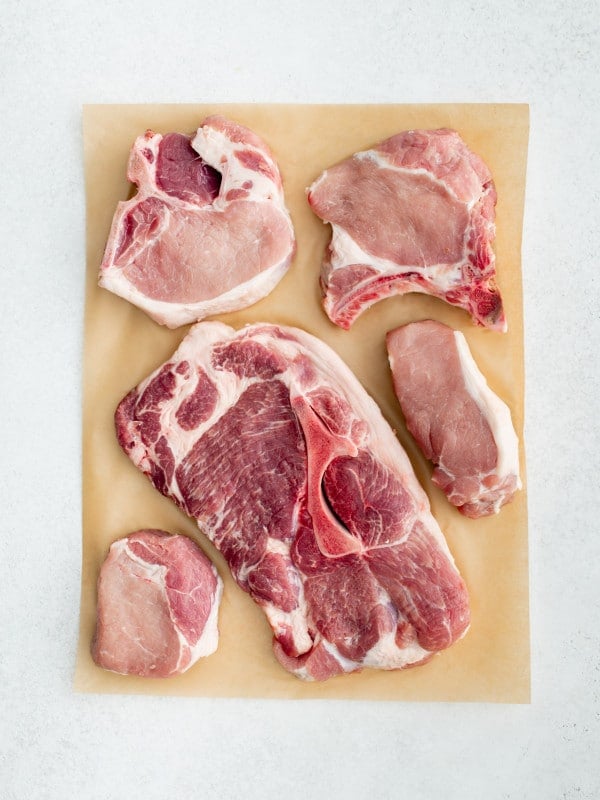This post may contain affiliate links. See my disclosure policy.
The Cajun Holy Trinity is an essential flavor base made from onion, celery, and bell pepper, and the backbone of countless Louisiana classics like gumbo, jambalaya, and étouffée. Learn how to make your own Cajun Trinity, and discover how to use this bold and aromatic trio.

If you’ve ever made a pot of jambalaya or shrimp étouffée, chances are you’ve already experienced the unmistakable flavor foundation known as the Holy Trinity of Cajun and Creole cooking. Consisting of onion, bell pepper, and celery, this essential trio of humble ingredients may not seem like much, but they’re the very backbone of culinary tradition in Louisiana.
Table of Contents
- A Flavor Foundation with Deep Roots
- What is the Holy Trinity of Cajun Cooking?
- Why is it Called ‘The Holy Trinity’?
- Why Green Bell Peppers?
- How to Make the Holy Trinity
- What Comes First: Roux, Meat, Or the Cajun Trinity?
- Variations of the Cajun Trinity
- How to Freeze the Cajun Trinity
- More Cajun Recipes
- Cajun Holy Trinity Recipe
A Flavor Foundation with Deep Roots
Shaped by centuries of migration, colonization, and adaption, Cajun and Creole cooking is as diverse as it gets. To truly appreciate the Holy Trinity for what it is (and Cajun and Creole cooking as a whole) it’s important to understand where it came from.
- French: The most dominant influence, French colonists brought their culinary techniques to the region in the 18th century. French settlers known as Acadians (who later became known as Cajuns), brought techniques like roux-based sauces, braising, and bold smoked sausage (hello, andouille sausage), and the foundational idea of aromatic vegetable blends (like the French mirepoix, which inspired the Holy Trinity).
- Spanish: Spain ruled Louisiana from 1763 to 1800 and with them came bold spices, rice, tomatoes, and one-pot cooking techniques. One of the most lasting contributions is jambalaya, a dish that evolved directly from paella. Spanish cuisine also relies on spices to build flavor, you’ll see this carry over in the form of paprika, chili powders, and other dried spices popular in both Creole seasoning and Cajun seasoning blends.
- West African: Enslaved Africans brought with them okra (used in gumbo), black-eyed peas, and deep flavor-building techniques. Many stews, gumbos, and rice-based dishes echo West African culinary traditions.
- Native American: Local Indigenous tribes contributed native ingredients like filé powder (ground sassafras leaves, used to thicken gumbo), and knowledge of wild game, seafood, and local herbs.
- German: German immigrants arrived in southern Louisiana in the early 1700s. With them they brought their sausage-making knowledge, as well as curing and smoking meats.
What is the Holy Trinity of Cajun Cooking?
The Holy Trinity is a classic mix of finely diced aromatic vegetables including onion, green bell pepper, and celery. Typically sautéed in a small amount of oil, butter, or fat over medium heat, they are cooked low and slow until soft and sweet, but not browned. They form the first layer of flavor in classic Louisiana recipes like gumbo, jambalaya, étouffée, red beans and rice, Cajun dirty rice, and more. Without it, these dishes simply wouldn’t taste the same.
The traditional ratio is 1 or 2 parts onion, 1 part green bell pepper, and 1 part celery.
Shortly after the trinity has softened, garlic may be added (this is called ‘adding the Pope’). You may also see tomatoes, herbs, or spices added to the mix, especially in Creole cuisine.

Why is it Called ‘The Holy Trinity’?
Some of Louisiana’s earliest settlers, the Acadians, were devout followers of the Catholic faith. The Holy Trinity in the Catholic Church refers to one God in three distinct persons: the Father, the Son, and the Holy Spirit. They are co-equal, co-eternal, and of one divine essence, meaning they are all part of one God. In a similar sense, the onion, green bell pepper, and celery in Cajun and Creole cooking are three parts to one essential flavor base.
The true origin of ‘holy trinity’ in reference to onion, bell pepper, and celery, is unknown, but it became ubiquitous in the 1970s thanks to chef Paul Prudhomme who helped popularize Cajun and Creole Cuisine through is 11 cookbooks, food products, and restaurant, K-Paul’s Louisiana Kitchen (source).
Why Green Bell Peppers?
When French settlers and Acadian exiles (later known as Cajuns) arrived in Louisiana, they brought their culinary traditions with them—including mirepoix, the classic blend of onion, celery, and carrots. So why did carrots get left behind?
There are a few reasons. One theory is that carrots didn’t grow well in Louisiana’s hot, humid climate and sandy soil. Another is that bell peppers, native to the Americas, were more abundant and easier to find (source). Over time, green bell peppers replaced carrots in the mix, creating the bold and distinctly Southern base we now know as the Holy Trinity.
How to Make the Holy Trinity
All you need to make the Cajun Trinity is onion, green bell pepper, celery, and either butter, oil, or animal fat. The ratio for the three vegetables is typically 2:1:1 or 1:1:1. I lean towards more onion, so my ratio is typically 2 parts onion, 1 part green bell pepper, and 1 part celery.
Here’s the basic step-by-step instructions for making the holy trinity:
- Trim the root ends and tops from the onions and celery. Rinse the celery and bell pepper thoroughly and pat dry. Remove the seeds and core from the bell pepper. (Tip: Save the vegetable trimmings in a freezer-safe bag to use later for homemade stock.)
- Dice the onion, celery, and bell pepper to suit your recipe. For sautéed dishes like étouffée or jambalaya, aim for a small chop (¼ to ½ inch). For soups or stews, a medium chop (½ to 1 inch) works well. Larger cuts (1 to 2 inches) are fine for stock or blended soups.
- Add 1 to 2 tablespoons of oil, butter, or fat to a large skillet set over medium-low heat. Stir in the diced vegetables and cook, stirring occasionally, for 10 to 12 minutes or until softened and the onions are translucent. Adjust the heat as needed to avoid browning—you’re looking for a gentle sauté to draw out the flavor.
Once you’ve built your flavorful base, you’re free to continue with the remaining steps in whatever recipe you’re cooking up!

Cooking with the Holy Trinity
What Comes First: Roux, Meat, Or the Cajun Trinity?
The order of things will depend on the dish – does it have a roux? Is it meat or seafood based? Or both?
In general, if you have meat (ground meat, chicken, pork, andouille sausage) you’ll always start there. You’ll sear sausage and usually brown meats until the fat is rendered and it’s deeply browned. Afterward, you’ll scoop the meat from the pan, set it aside, and leave behind the fat drippings.
If the recipe calls for making a roux, that comes next. A roux is a combination of fat and flour that’s used to flavor and to thicken dishes like stews and sauces. A good roux is hallmark to a good gumbo and it can take anywhere from 10 minutes to more than an hour to make.
If the recipe doesn’t include a roux, no problem. You’ll skip it and move to the next step which is to cook the Cajun Trinity. In the case of no roux, simply cook the onion, green bell pepper, and celery in the rendered fat until softened. If you do have a roux, stir the vegetables directly into the roux. This stops the roux from cooking further, and allows the Trinity to soften.
And what about seafood? Well, fish and shellfish is always added and cooked last.
Variations of the Cajun Trinity
Aside from the Holy Trinity of Cajun and Creole cooking (onion, green bell pepper, and celery) and the French mirepoix (onion, carrot, and celery), here are a few other variations that you’ll find throughout the World.
- Spanish Sofrito: Sofrito, which means “lightly fried,” is a savory blend of onions, garlic, tomatoes, and (sometimes) green bell peppers, gently cooked in olive oil. This aromatic mixture is a key flavor base used in many Spanish dishes, including paella, stews, and pasta. Variations of sofrito are also found throughout Latin America and Portugal, each with regional twists and local ingredients. Puerto Rican Sofrito, for example, is made with a base of aji dulce (sweet chili peppers), green bell pepper, onion, garlic, culantro (or cilantro), and olive oil.
- German Suppengrün: Meaning “soup greens” in German, suppengrün is a traditional flavor base made from leeks, carrots, and celery root (celeriac). It’s commonly used to flavor broths, soups, and stews. Variations may include other hardy vegetables like onions, rutabaga, or herbs like parsley and thyme.
- Polish Włoszczyzna: The Polish version of a soup starter mix, it traditionally includes carrot, parsley root, celery root (celeriac), and leek. Some versions also add cabbage leaves or parsley stems for extra flavor. The vegetables are often tied together and simmered whole to build the base for many classic Polish soups and broths, like rosół (clear chicken soup) or żurek (sour rye soup).
How to Freeze the Cajun Trinity
You can freeze the Holy Trinity before or after cooking. Here’s how:
Before cooking: Blanching before freezing isn’t necessary
- Chop the vegetables: Dice the onion, celery, and bell pepper to your desired size.
- Portion and pack: Add to freezer-safe bags or containers in 1-cup portions.
- Freeze: Flatten the bags for easy storage and freeze for up to 3 months.
After cooking: Thawing before adding to recipes like gumbo and soups is not necessary.
- Sauté the trinity: Cook in oil or butter until softened.
- Cool and pack: Let it cool completely, then portion it into freezer-safe containers or bags.
- Freeze: Freeze up to 3 months.
More Cajun Recipes
Have you tried this Cajun Trinity recipe? Tell me about it in the comments below! I always love to hear your thoughts. And tag #theforkedspoon on Instagram if you’ve made any of my recipes, I always love to see what you’re cooking in the kitchen.

Cajun Holy Trinity Recipe
Ingredients
- 1-2 cups onion, chopped
- 1 cup green bell pepper, cored and deseeded, chopped
- 1 cup celery, chopped
- 1 tablespoon oil, butter, or lard
Instructions
- Prepare the vegetables: Trim the root ends and tops from the onion and celery. Rinse the celery and bell pepper thoroughly and pat dry. Remove the seeds and core from the bell pepper.
- Chop the onion, celery, and bell pepper. Use the following as a guideline: for sautéed recipes, small chop (¼ to ½ inch). For soups or stews, a medium chop (½ to 1 inch), and for stocks, broth, or blended soup, larger cuts (1 to 2 inches).
- Cook: Heat oil, butter, or rendered animal fat in a large skillet or pot over medium-low heat. Add the vegetables an cook for 10-12 minutes, or until softened, sweetened, and the onions are completely translucent.
- Use as needed or transfer to an airtight container in the fridge for up to 5 days or freezer for up to 3 months.
Notes
Nutrition
Nutrition information is automatically calculated, so should only be used as an approximation.

















